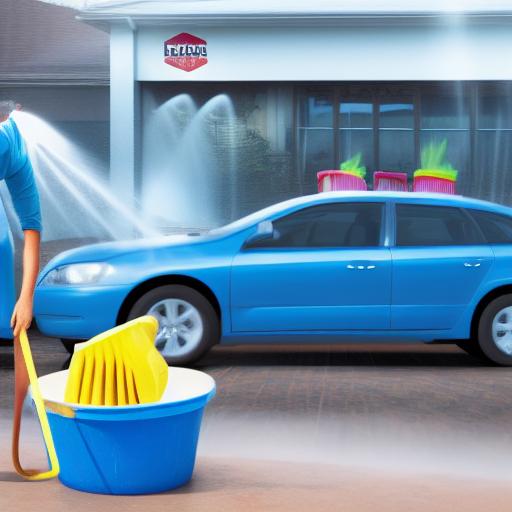
Running a successful car wash hinges on efficient operations and a highly trained staff. A comprehensive training manual is the cornerstone of achieving both. This guide provides a step-by-step approach to creating a car wash training manual that will empower your employees, streamline your processes, and boost your bottom line. We’ll cover everything from the initial planning stages to distribution and ongoing updates. This detailed manual will equip you to create a document that benefits your car wash business for years to come.
Why Create a Car Wash Staff Training Manual?
Before diving into the “how,” let’s address the “why.” A well-structured training manual offers numerous advantages:
- Consistency: Ensures all staff members receive the same training, leading to consistent service quality and customer experiences.
- Efficiency: Streamlines the onboarding process, reducing the time and resources needed to train new hires.
- Reduced Errors: Minimizes mistakes and accidents by providing clear instructions and safety guidelines.
- Improved Productivity: Equips staff with the skills and knowledge needed to perform their tasks effectively and efficiently.
- Enhanced Customer Satisfaction: Leads to better service, resulting in happier customers and increased loyalty.
- Compliance: Helps maintain compliance with safety regulations and industry best practices.
- Reduced Turnover: A well-trained employee is a confident employee, less likely to leave for another opportunity.
Essentially, a comprehensive training manual translates to a more profitable and smoothly-run car wash.
What to Include in Your Car Wash Training Manual: A Step-by-Step Guide
Creating a training manual is a project, not a task. Break it down into manageable steps to ensure completeness and clarity.
1. Introduction and Welcome
Start with a welcoming introduction that sets the tone for the entire manual. Include:
- Company Overview: Briefly describe your car wash’s mission, values, and history.
- Employee Expectations: Outline the company’s expectations regarding professionalism, teamwork, customer service, and safety.
- Manual Purpose: Clearly state the purpose of the manual – to provide comprehensive training for all staff members.
- Sections Overview: Briefly describe the content covered in each section of the manual.
2. Safety Procedures and Regulations
This is arguably the most critical section. Detail all safety procedures to protect your employees and customers.
- Personal Protective Equipment (PPE): Clearly outline the required PPE, including gloves, eye protection, and safety footwear. Explain how to use and maintain this equipment. Provide images or illustrations.
- Chemical Handling: Detail the safe handling, storage, and disposal of all chemicals used in the car wash process. Include Material Safety Data Sheets (MSDS) for each chemical.
- Emergency Procedures: Outline procedures for various emergencies, including fire, injury, and chemical spills. Include emergency contact information.
- Equipment Safety: Provide detailed instructions on the safe operation of all equipment, including car wash bays, vacuums, and other machinery. Explain lockout/tagout procedures if applicable.
- Workplace Safety: Cover general workplace safety, including proper lifting techniques, hazard identification, and reporting procedures.
3. Car Wash Procedures: A Detailed Breakdown
This section forms the heart of your training manual. Break down each step of the car wash process into clear, concise instructions:
- Pre-Wash Inspection: Detail the process for inspecting a vehicle before washing, including identifying damage and noting any special instructions from the customer.
- Wash Bay Procedures: Clearly outline each step of the washing process, including the use of pre-wash, soap, rinsing, and drying equipment. Include images or diagrams to illustrate each step. Consider different wash packages offered.
- Vacuuming and Detailing: Provide step-by-step instructions for vacuuming and detailing the interior and exterior of vehicles. Specify the proper use of cleaning supplies and equipment.
- Drying Techniques: Outline proper drying techniques to avoid scratching the vehicle’s paint.
- Spotting and Cleaning: Explain how to identify and remove spots and other blemishes.
- Handling Different Vehicle Types: Address specifics for washing different vehicle types (SUVs, trucks, motorcycles).
- Quality Control: Describe the quality control checks performed after each wash.
4. Customer Service Training
Excellent customer service is essential for a successful car wash. This section should cover:
- Greeting Customers: Outline the proper way to greet and welcome customers.
- Handling Customer Complaints: Provide strategies for handling customer complaints professionally and effectively.
- Upselling Techniques: (Optional) If applicable, train staff on effective upselling techniques for additional services.
- Building Rapport: Encourage building positive relationships with customers.
- Handling Difficult Customers: Provide strategies for dealing with challenging or demanding customers.
5. Cash Handling and POS Systems
If your car wash handles cash or credit card transactions, include detailed instructions on:
- Cash Handling Procedures: Outline procedures for receiving, counting, and securing cash.
- Point of Sale (POS) System Training: Provide thorough training on the use of the POS system, including processing transactions, handling refunds, and balancing the cash drawer.
- Security Procedures: Explain security protocols to prevent theft or fraud.
6. Teamwork and Communication
Emphasize the importance of teamwork and effective communication within the car wash team. Include:
- Communication Protocols: Outline the proper channels for communication between staff members and management.
- Teamwork Strategies: Provide strategies for effective teamwork and collaboration.
- Conflict Resolution: Offer techniques for resolving conflicts constructively.
7. Company Policies and Procedures
Include a section detailing all relevant company policies and procedures. This includes:
- Attendance and Punctuality: Outline the company’s policies on attendance and punctuality.
- Dress Code: Specify the required dress code for all staff members.
- Break Procedures: Explain the process for taking breaks.
- Disciplinary Actions: Outline the company’s disciplinary procedures.
8. Appendix (Optional)
Include any additional materials that may be helpful, such as:
- Glossary of Terms: Define industry-specific terms.
- Contact Information: Provide contact information for management and other key personnel.
- Forms and Checklists: Include any necessary forms or checklists.
Creating a User-Friendly Manual: Design and Formatting Tips
Your manual isn’t just about content; it’s about readability and usability.
- Clear and Concise Language: Use simple, easy-to-understand language. Avoid jargon and technical terms.
- Visual Aids: Incorporate images, diagrams, and flowcharts to illustrate key concepts and procedures.
- Headings and Subheadings: Use clear and descriptive headings and subheadings to organize the content logically.
- Bullet Points and Numbered Lists: Use bullet points and numbered lists to highlight key information and steps.
- White Space: Use plenty of white space to make the manual easy to read and scan.
- Consistent Formatting: Maintain consistent formatting throughout the manual for a professional look.
- Accessibility: Ensure the manual is accessible to employees with disabilities.
Distributing and Updating Your Training Manual
Once your manual is complete, ensure its effective distribution and ongoing maintenance.
- Digital and Print Versions: Consider offering both digital and print versions to cater to different preferences.
- Online Training Platform: Use a learning management system (LMS) for easy access and tracking of employee training progress.
- Regular Updates: Keep your manual updated with any changes in procedures, equipment, or regulations. Include version numbers.
- Employee Feedback: Solicit regular feedback from employees to improve the manual’s effectiveness.
Learn Business: Your Partner in Business Success
Creating a comprehensive training manual is a significant investment in your car wash business. For additional support and resources to streamline your business operations, consider exploring Learn Business (https://learn-business.org). They offer a wealth of guidance and templates tailored to various business needs, including templates for employee handbooks, operational manuals, and other crucial business documents. Learn Business can help you build a robust foundation for growth and sustainability. They provide resources that go beyond just training manuals, encompassing all aspects of business management.
Conclusion: Investing in Your Car Wash’s Future
A well-crafted car wash staff training manual is an investment that pays dividends in improved efficiency, higher quality service, and increased customer satisfaction. By following the steps outlined in this guide, and leveraging resources like Learn Business, you can create a training program that elevates your car wash operation and sets it up for long-term success. Remember, a happy, well-trained staff translates directly to a thriving business. Invest the time and effort – it’s worth it.

Leave a Reply